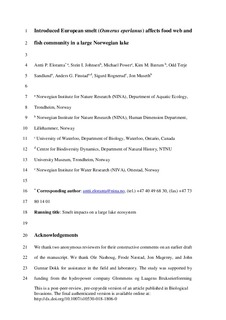Introduced European smelt (Osmerus eperlanus) affects food web and fish community in a large Norwegian lake
Eloranta, Antti; Johnsen, Stein Ivar; Power, Michael; Bærum, Kim Magnus; Sandlund, Odd Terje; Finstad, Anders Gravbrøt; Rognerud, Sigurd; Museth, Jon
Journal article, Peer reviewed
Accepted version

Åpne
Permanent lenke
http://hdl.handle.net/11250/2558584Utgivelsesdato
2018Metadata
Vis full innførselSamlinger
- Publikasjoner fra CRIStin - NINA [2397]
- Scientific publications [1423]
Originalversjon
https://doi.org/10.1007/s10530-018-1806-0Sammendrag
Invasive and introduced fishes can affect recipient ecosystems and native species via altered competitive and predatory interactions, potentially leading to top-down and bottom-up cascading impacts. Here, we describe a case from a large lake in southern Norway, Storsjøen, where the illegal introduction of a small, predominantly planktivorous fish species, European smelt (Osmerus eperlanus), has led to changes in the native fish community and lake food web. Survey fishing data collected before (2007) and after (2016) the introduction indicates that smelt has become the numerically dominant fish species both in benthic and pelagic habitats, with concurrent reductions in the relative abundance of native European whitefish (Coregonus lavaretus) and Arctic charr (Salvelinus alpinus) populations. Stable isotope (d13C and d15N) data indicate minor changes in the trophic niches of native whitefish and Arctic charr despite partly overlapping niches with the introduced smelt. In contrast, brown trout (Salmo trutta) showed an earlier shift to piscivory, a more pelagic niche and increased growth rate, likely because of the smelt induced increase in pelagic prey fish abundance. The main trophic pathway supporting top predators (i.e., large brown trout) in Storsjøen has, therefore, shifted from a littoral to a more pelagic base. Our study demonstrates that small-sized introduced fishes can alter lake foodweb dynamics, with contrasting impacts on native fishes. This knowledge is vital for future evaluation and mitigation of potential impacts of smelt introductions on lake ecosystems.